engine Peugeot 508 2012 Owner's Manual - RHD (UK, Australia)
[x] Cancel search | Manufacturer: PEUGEOT, Model Year: 2012, Model line: 508, Model: Peugeot 508 2012Pages: 340, PDF Size: 11.13 MB
Page 4 of 340
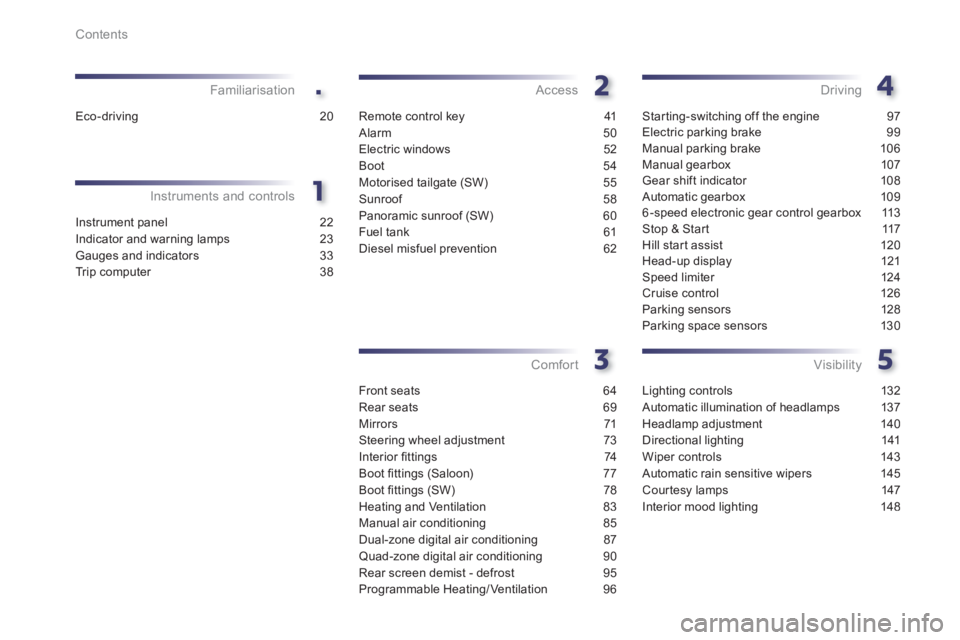
.
Contents
Instrument panel 22
Indicator and warning lamps 23
Gauges and indicators 33
Tr ip computer 38
Instruments and controlsFamiliarisation
Remote control key 41
Alarm 50
Electric windows 52
Boot 54
Motorised tailgate (SW) 55
Sunroof 58
Panoramic sunroof (SW) 60
Fuel tank 61
Diesel misfuel prevention 62
Access
Front seats 64
Rear seats 69
Mirrors 71
Steering wheel adjustment 73
Interior fi ttings 74
Boot fi ttin
gs (Saloon) 77
Boot fi ttings (SW) 78
Heating and Ventilation 83
Manual air conditioning 85
Dual-zone digital air conditioning 87
Quad-zone digital air conditioning 90
Rear screen demist - defrost 95
Programmable Heating/Ventilation 96
Comfort
Starting-switching off the engine 97Electric parking brake 99Manual parking brake 106Manual gearbox 107Gear shift indicator 108Automatic gearbox 1096-speed electronic gear control gearbox 113Stop & Start 117Hill start assist 120Head-up display 121Speed limiter 124Cruise control 126Parking sensors 128Parking space sensors 130
Driving
Lighting controls 132
Automatic illumination of headlamps 137
Headlamp adjustment 140
Directional lighting 141
Wiper controls 143
Automatic rain sensitive wipers 145
Cour tesy lamps 147
Interior mood lighting 148
Visibility
Eco-driving 20
Page 5 of 340
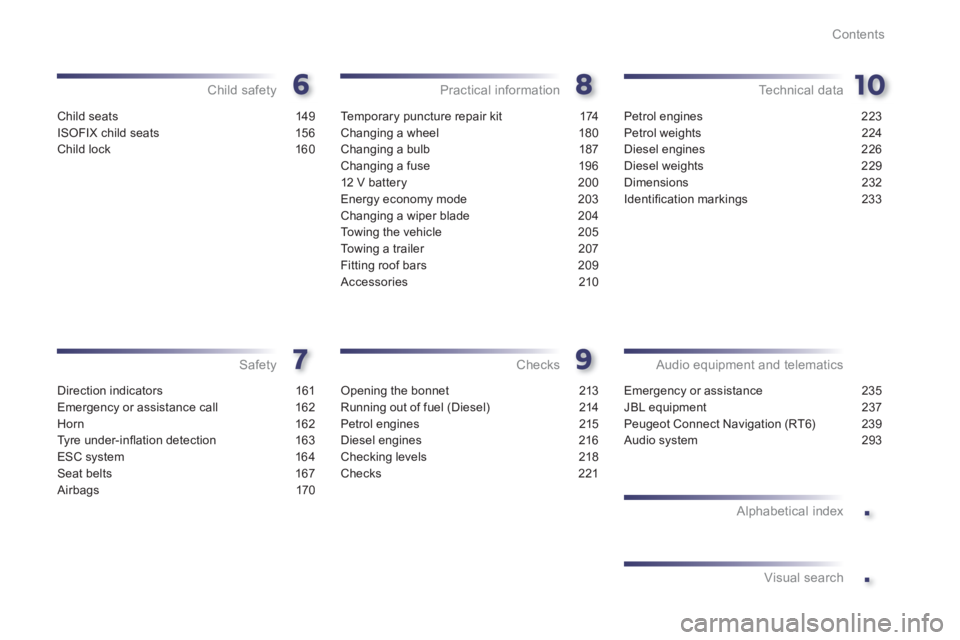
.
.
Contents
Child seats 149
ISOFIX child seats 156
Child lock 160
Child safety
Direction indicators 161
Emergency or assistance call 162
Horn 162
Tyre under-infl ation detection 163
ESC system 164
Seat belts 167
Airbags 170
Safety
Te m p o r a ry puncture repair kit 174
Changing a wheel 180
Changing a bulb 187
Changing a fuse 196
12 V battery 200
Energy economy mode 203
Changing a wiper blade 204
To w i ng the vehicle 205
To w i ng a trailer 207
Fitting roof bars 209
Accessories 210
Practical information
Opening the bonnet 213
Running out of fuel (Diesel) 214
Petrol engines 215
Diesel engines 216
Checking levels 218
Checks 221
Checks
Petrol engines 223
Petrol weights 224
Diesel en
gines 226
Diesel weights 229
Dimensions 232
Identifi cation markings 233
Technical data
Emergency or assistance 235
JBL equipment 237
Peugeot Connect Navigation (RT6) 239
Audio system 293
Audio equipment and telematics
Alphabetical index
Visual search
Page 6 of 340
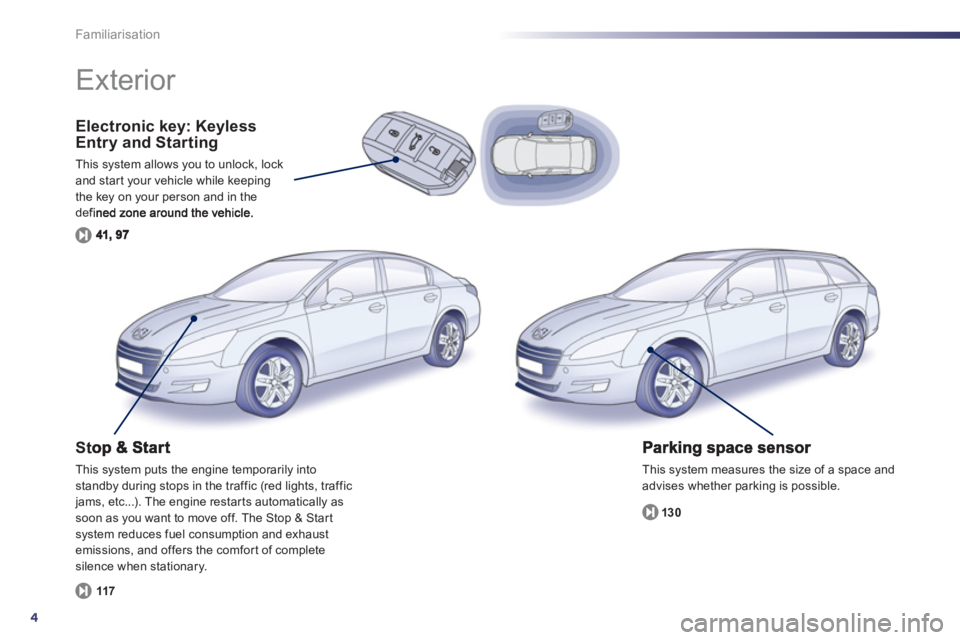
4
Familiarisation
Electronic key: KeylessEntry and Starting
This system allows you to unlock, lockand star t your vehicle while keepingthe key on your person and in the defined zone around the vehicle.
This system measures the size of a space and
advises whether parking is possible.
13
0
Exterior
St
This system puts the engine temporarily into standby during stops in the traffic (red lights, traffic jams, etc...). The engine restar ts automatically as soon as you want to move off. The Stop & Start system reduces fuel consumption and exhaustemissions, and offers the comfor t of complete silence when stationary.
117
Page 18 of 340
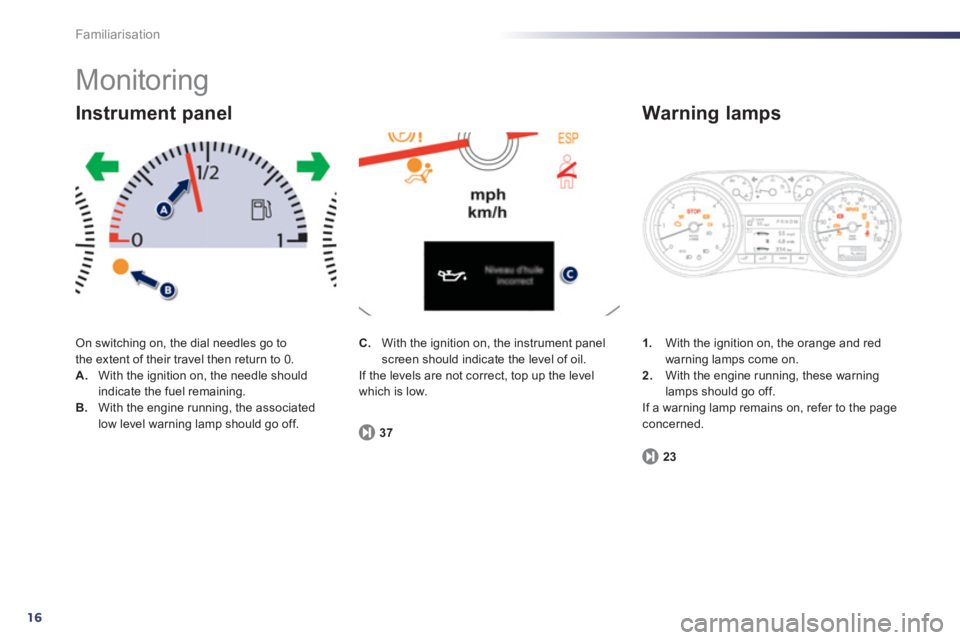
16
Familiarisation
Monitoring
On switching on, the dial needles go to
the extent of their travel then return to 0. A. With the ignition on, the needle shouldindicate the fuel remaining. B.With the engine running, the associated low level warning lamp should go off.
Instrument panel
1.
With the ignition on, the orange and red
warning lamps come on.2.With the engine running, these warninglamps should go off.
If a warning lamp remains on, refer to the page concerned.
Warning lamps
23
C.
With the ignition on, the instrument panelscreen should indicate the level of oil.
If the levels are not correct, top up the level
whi
ch is low.
3
7
Page 20 of 340
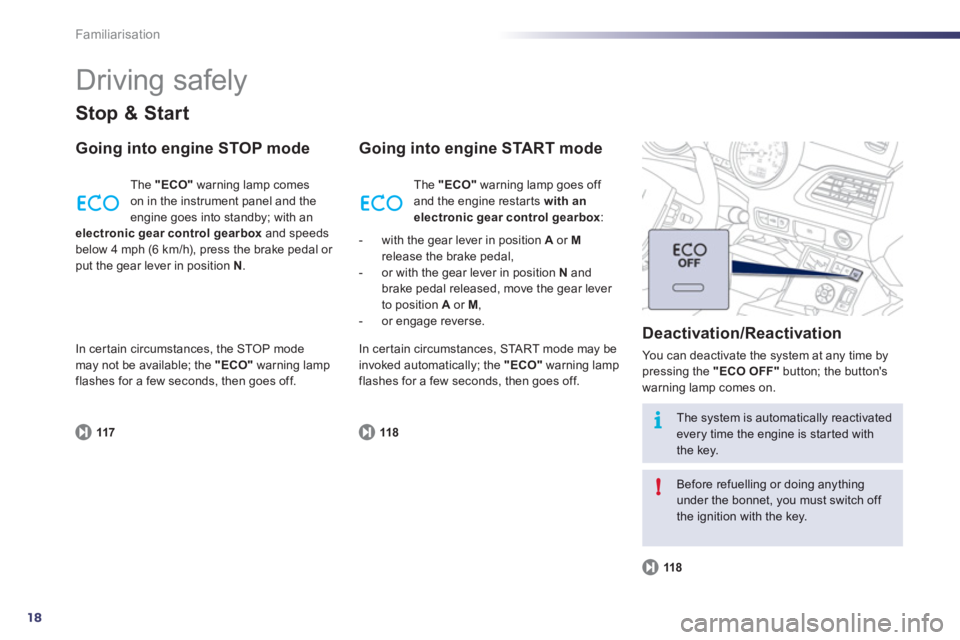
18
i
!
Familiarisation
Driving safely
Stop & Start
Going into engine STOP mode
117
The "ECO"warning lamp comes
on in the instrument panel and the
engine goes into standby; with anelectronic gear control gearbox and speeds
below 4 mph (6 km/h), press the brake pedal or put the gear lever in position N.
Going into engine START mode
Deactivation
/Reactivation
You can deactivate the system at any time bypressing the "ECO OFF"
button; the button's
warning lamp comes on.
118
118
The system is automatically reactivated every time the engine is star ted withthe key.
Before refuelling or doing anything under the bonnet, you must switch off the ignition with the key. Th
e "ECO"
warning lamp goes off
and the engine restar ts with anelectronic gear control gearbox:
- with the gear lever in position A
or Mrelease the brake pedal,
- or with the gear lever in position N
andbrake pedal released, move the gear lever
to position Aor M ,
- or engage reverse.
In certain circumstances, the ST
OP modemay not be available; the "ECO"
warning lamp
flashes for a few seconds, then goes off. In certain circumstances,
STA R T m o d e m ay be
invoked automatically; the "ECO"warning lampflashes for a few seconds, then goes off.
Page 21 of 340
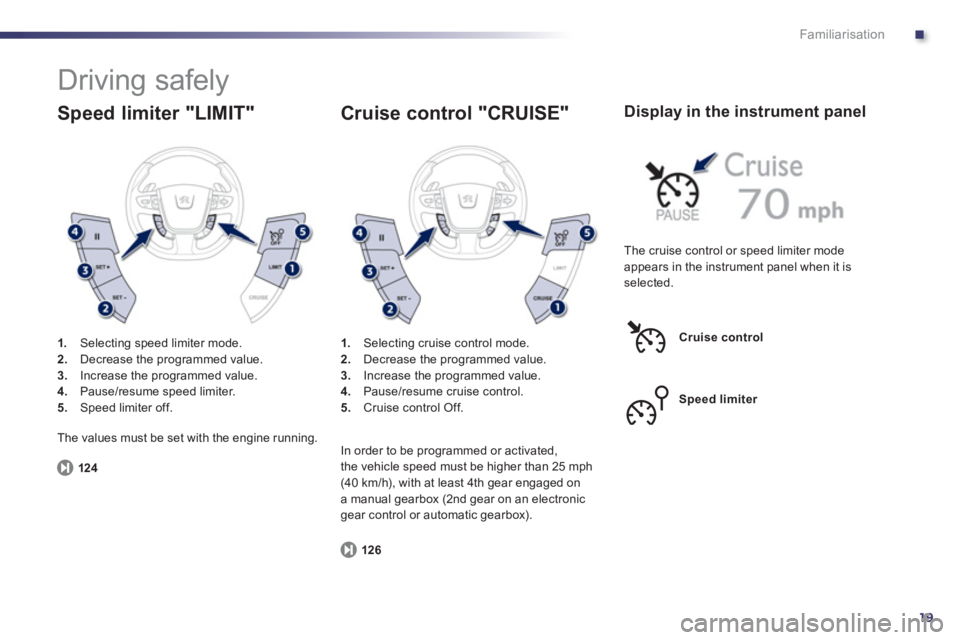
.
19
Familiarisation
Driving safely
1.
Selecting speed limiter mode.2.Decrease the programmed value.3.Increase the programmed value.4.
Pause/resume speed limiter.
5. Speed limiter off.
Speed limiter "LIMIT"
1241
.Selecting cruise control mode.
2. Decrease the programmed value. 3.
Increase the programmed value. 4.
Pause/resume cruise control.
5. Cruise control Off.
Cruise control "CRUISE"
126
The cruise control or speed limiter mode
appears in the instrument panel when it is
selected.
Display in the instrument panel
Cruise control
S
peed limiter
The values must be set with the engine running. In order to be programmed or activated,
the vehicle speed must be higher than 25 mph (40 km/h), with at least 4th gear engaged on a manual gearbox (2nd gear on an electronicgear control or automatic gearbox).
Page 22 of 340
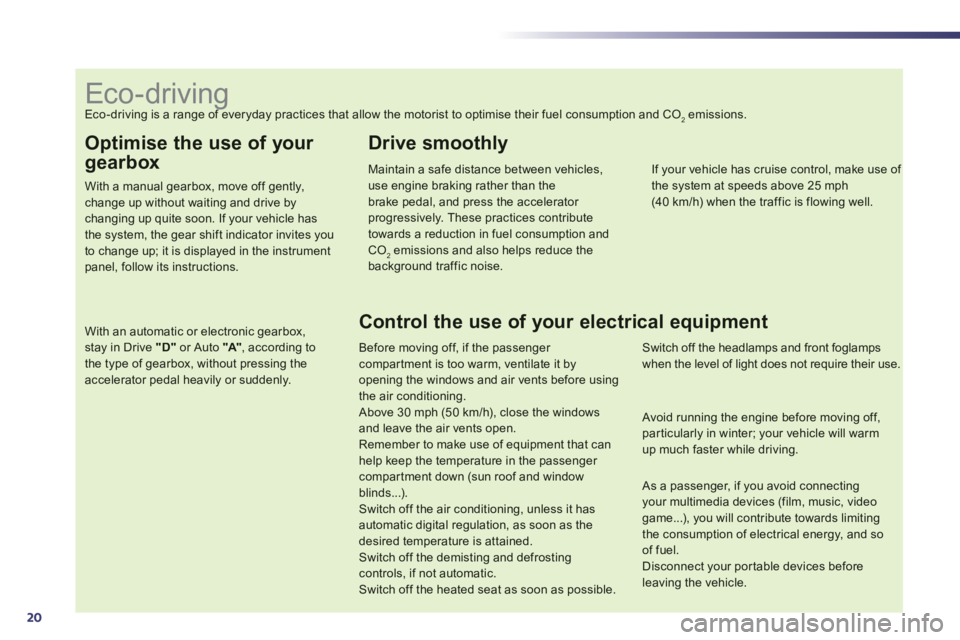
20
Optimise the use of your
gearbox
With a manual gearbox, move off gently,change up without waiting and drive by changing up quite soon. If your vehicle has the system, the gear shift indicator invites youto change up; it is displayed in the instrumentpanel, follow its instructions.
With an automatic or electronic gearbox, stay in Drive "D"or Auto "A" , according to the type of gearbox, without pressing theaccelerator pedal heavily or suddenly.
Drive smoothly
Maintain a safe distance between vehicles,use engine braking rather than thebrake pedal, and press the accelerator progressively. These practices contributetowards a reduction in fuel consumption andCO2emissions and also helps reduce thebackground traffic noise.
If your vehicle has cruise control, make use of the system at speeds above 25 mph (40 km/h) when the traffic is flowing well.
Control the use of your electrical equipment
Before moving off, if the passenger compartment is too warm, ventilate it byopening the windows and air vents before using the air conditioning.
Above 30 mph (50 km/h), close the windows and leave the air vents open.
Remember to make use of equipment that canhelp keep the temperature in the passenger compartment down (sun roof and windowblinds...).
Switch off the air conditioning, unless it has automatic digital regulation, as soon as thedesired temperature is attained. Switch off the demisting and defrostingcontrols, if not automatic. Switch off the heated seat as soon as possible.
Switch off the headlamps and front foglamps when the level of light does not require their use.
Avoid running the engine before moving off,
particularly in winter; your vehicle will warmup much faster while driving.
As a passenger, if you avoid connecting your multimedia devices (film, music, videogame...), you will contribute towards limitingthe consumption of electrical energy, and soof fuel.
Disconnect your por table devices beforeleaving the vehicle.
Eco-driving Eco-driving is a range of everyday practices that allow the motorist to optimise their fuel consumption and CO2emissions.
Page 23 of 340
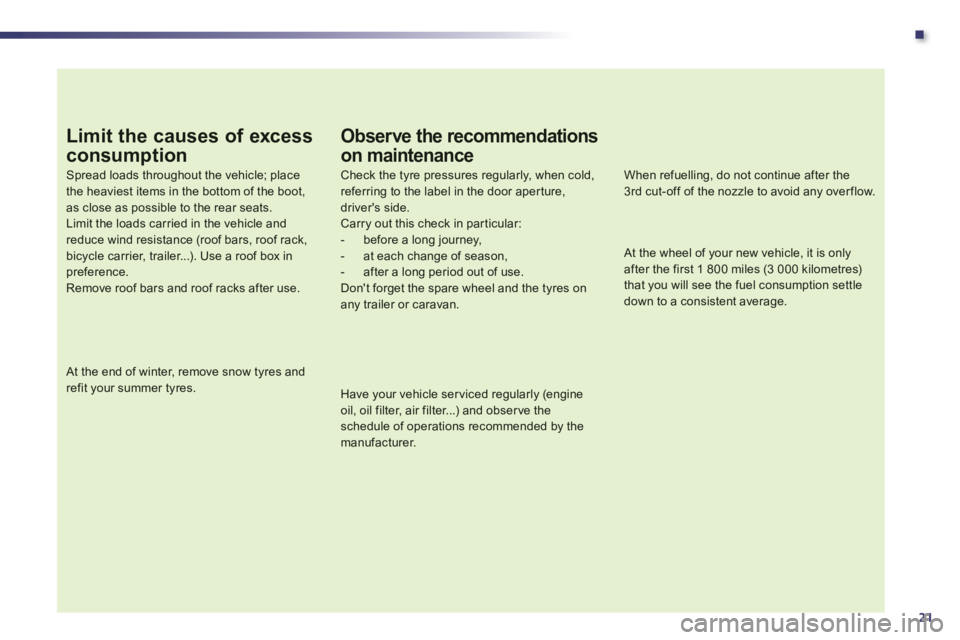
.
21
Limit the causes of excess
consumption
Spread loads throughout the vehicle; placethe heaviest items in the bottom of the boot,as close as possible to the rear seats.Limit the loads carried in the vehicle and reduce wind resistance (roof bars, roof rack, bicycle carrier, trailer...). Use a roof box inpreference.Remove roof bars and roof racks after use.
At the end of winter, remove snow tyres and refit your summer tyres.
Observe the recommendations
on maintenance
Check the tyre pressures regularly, when cold, referring to the label in the door aper ture, driver's side.Carry out this check in par ticular:- before a long journey,- at each change of season,- after a long period out of use. Don't forget the spare wheel and the tyres onany trailer or caravan.
Have your vehicle ser viced regularly (engine oil, oil filter, air filter...) and obser ve the schedule of operations recommended by the
manufacturer.
When refuelling, do not continue after the3 rdcut-off of the nozzle to avoid any over flow.
At the wheel of your new vehicle, it is only after the first 1 800 miles (3 000 kilometres) that you will see the fuel consumption settledown to a consistent average.
Page 24 of 340
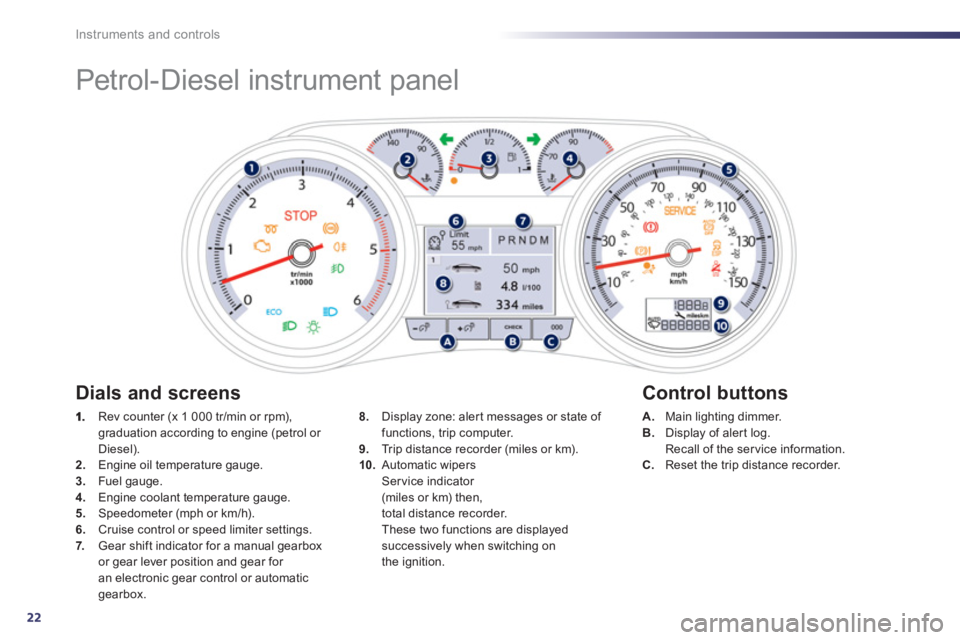
22
Instruments and controls
Petrol-Diesel instrument panel
Rev counter (x 1 000 tr/min or rpm), graduation according to engine (petrol or Diesel).2.
Engine oil temperature gauge. 3.Fuel gauge.4.
Engine coolant temperature gauge. 5.
Speedometer (mph or km/h).
6.Cruise control or speed limiter settings.
7. Gear shift indicator for a manual gearbox
or gear lever position and gear for an electronic gear control or automatic gearbox.A
.Main lighting dimmer.
B.Display of aler t log.
Recall of the service information. C.Reset the trip distance recorder.
8.
Display zone: aler t messages or state of functions, trip computer.9.Trip distance recorder (miles or km).
10. Automatic wipers
Ser vice indicator
(miles or km) then,
total distance recorder.
These two functions are displayed successively when switching on
the ignition.
Dials and screens
Control buttons
Page 25 of 340
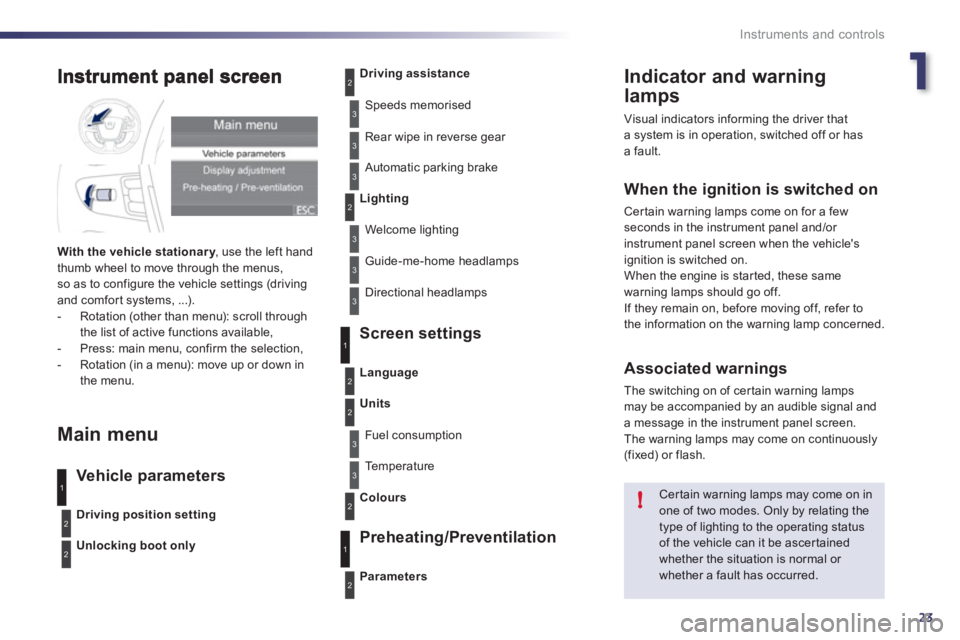
1
23
!
Instruments and controls
Indicator and warning
lamps
Visual indicators informing the driver that
a system is in operation, switched off or hasa fault.
When the ignition is switched on
Certain warning lamps come on for a few seconds in the instrument panel and/or
instrument panel screen when the vehicle's
ignition is switched on.
When the engine is started, these same
warning lamps should go off.
If they remain on, before moving off, refer to
the information on the warning lamp concerned.
Associated warnings
The switching on of cer tain warning lamps
may be accompanied by an audible signal and
a message in the instrument panel screen.
The warning lamps may come on continuously(fixed) or flash.
Certain warning lamps may come on inone of two modes. Only by relating thetype of lighting to the operating status
of the vehicle can it be ascertainedwhether the situation is normal or whether a fault has occurred.
1
2
2
2
3
3
3
2
3
3
With the vehicle stationar y, use the left handythumb wheel to move through the menus,so as to configure the vehicle settings (driving
and comfor t systems, ...).
- Rotation (other than menu): scroll through
the list of active functions available,
- Press: main menu, confirm the selection,
- Rotation (in a menu): move up or down in
the menu.
Main menu
Vehicle parameters Screen settin
gs
Preheatin
g/Preventilation
Driving position setting
Unlocking boot only
Driving assistance
Speeds memorised
Rear wipe in reverse
gear
Automatic parking brake
Lighting
Welcome lighting
Guide-me-home headlamps
Directional headlamps
Parameters
Language
Units
Fuel consumption
Te m p e r a t u r e
Colour
s
3
1
2
2
3
2
3
1
2